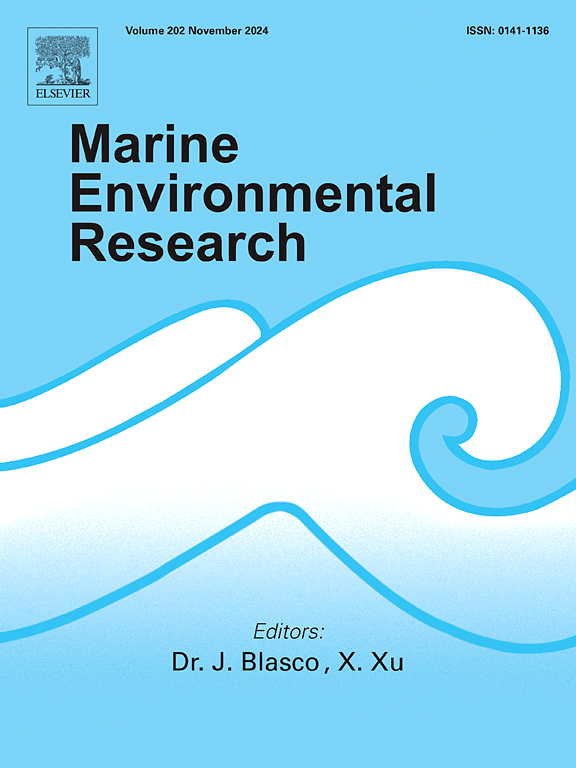Evaluating the potential impacts of mesoscale eddies on the distribution and abundance of an environmentally sensitive squid species (Sthenoteuthis oualaniensis) in the Arabian Sea
IF 3.2
3区 环境科学与生态学
Q2 ENVIRONMENTAL SCIENCES
引用次数: 0
Abstract
The purpleback flying squid (Sthenoteuthis oualaniensis) is widely distributed in the Arabian Sea and highly sensitive to environmental changes. Mesoscale eddies largely occur in the Arabian Sea, playing a significant role in regional biogeochemical processes. However, the impact of eddies on squid abundance is not well studied. Therefore, mesoscale eddies impacts on abundance and spatial distribution of S. oualaniensis were investigated in this study. The results indicated that the monthly catch-per-unit-effort (CPUE) of S. oualaniensis correlated with the variation in the number of eddies, and CPUE within cyclonic eddies (CE) was higher than that within anticyclonic eddies (AE). Sea surface temperature (SST), chlorophyll-a concentration (Chl-a), and dissolved oxygen at 150 m (DO150m) strongly affected the abundance of S. oualaniensis, showing distinct spatial distributions within CEs and AEs. These three key environmental factors were used to construct a habitat suitability index (HSI) model to evaluate the habitat distribution characteristics of S. oualaniensis within CEs and AEs, and results demonstrated CEs were more suitable. Within CEs, suitable SST and relatively lower DO150m aid in the growth and predator avoidance of S. oualaniensis. Overall, the eddies in the Arabian Sea regulate the abundance and distribution of S. oualaniensis, with CEs providing a more suitable habitat.
评估中尺度涡旋对阿拉伯海环境敏感鱿鱼物种(Sthenoteuthis oualaniensis)分布和丰度的潜在影响
紫背飞乌贼(Sthenoteuthis oualaniensis)广泛分布于阿拉伯海,对环境变化非常敏感。中尺度涡旋主要发生在阿拉伯海,在区域生物地球化学过程中起着重要作用。然而,涡流对鱿鱼丰度的影响还没有得到很好的研究。因此,本研究探讨了中尺度涡旋对瓦兰棘鱼丰度和空间分布的影响。结果表明:月单位努力渔获量(CPUE)与涡旋数的变化相关,且气旋涡旋(CE)内的CPUE高于反气旋涡旋(AE)内的CPUE;150m海面温度(SST)、叶绿素-a浓度(Chl-a)和溶解氧(DO150m)对S. oualaniensis丰度有显著影响,在ce和ae内具有明显的空间分布。利用这3个关键环境因子构建生境适宜性指数(HSI)模型,评价了南水北调在生态环境和生态环境中的生境分布特征,结果表明生态环境更适合南水北调。在ce范围内,适宜的海温和相对较低的do1.5 m有助于S. oualaniensis的生长和捕食者的躲避。总的来说,阿拉伯海的漩涡调节了S. oualaniensis的丰度和分布,ce提供了更适宜的栖息地。
本文章由计算机程序翻译,如有差异,请以英文原文为准。
求助全文
约1分钟内获得全文
求助全文
来源期刊

Marine environmental research
环境科学-毒理学
CiteScore
5.90
自引率
3.00%
发文量
217
审稿时长
46 days
期刊介绍:
Marine Environmental Research publishes original research papers on chemical, physical, and biological interactions in the oceans and coastal waters. The journal serves as a forum for new information on biology, chemistry, and toxicology and syntheses that advance understanding of marine environmental processes.
Submission of multidisciplinary studies is encouraged. Studies that utilize experimental approaches to clarify the roles of anthropogenic and natural causes of changes in marine ecosystems are especially welcome, as are those studies that represent new developments of a theoretical or conceptual aspect of marine science. All papers published in this journal are reviewed by qualified peers prior to acceptance and publication. Examples of topics considered to be appropriate for the journal include, but are not limited to, the following:
– The extent, persistence, and consequences of change and the recovery from such change in natural marine systems
– The biochemical, physiological, and ecological consequences of contaminants to marine organisms and ecosystems
– The biogeochemistry of naturally occurring and anthropogenic substances
– Models that describe and predict the above processes
– Monitoring studies, to the extent that their results provide new information on functional processes
– Methodological papers describing improved quantitative techniques for the marine sciences.
 求助内容:
求助内容: 应助结果提醒方式:
应助结果提醒方式:


